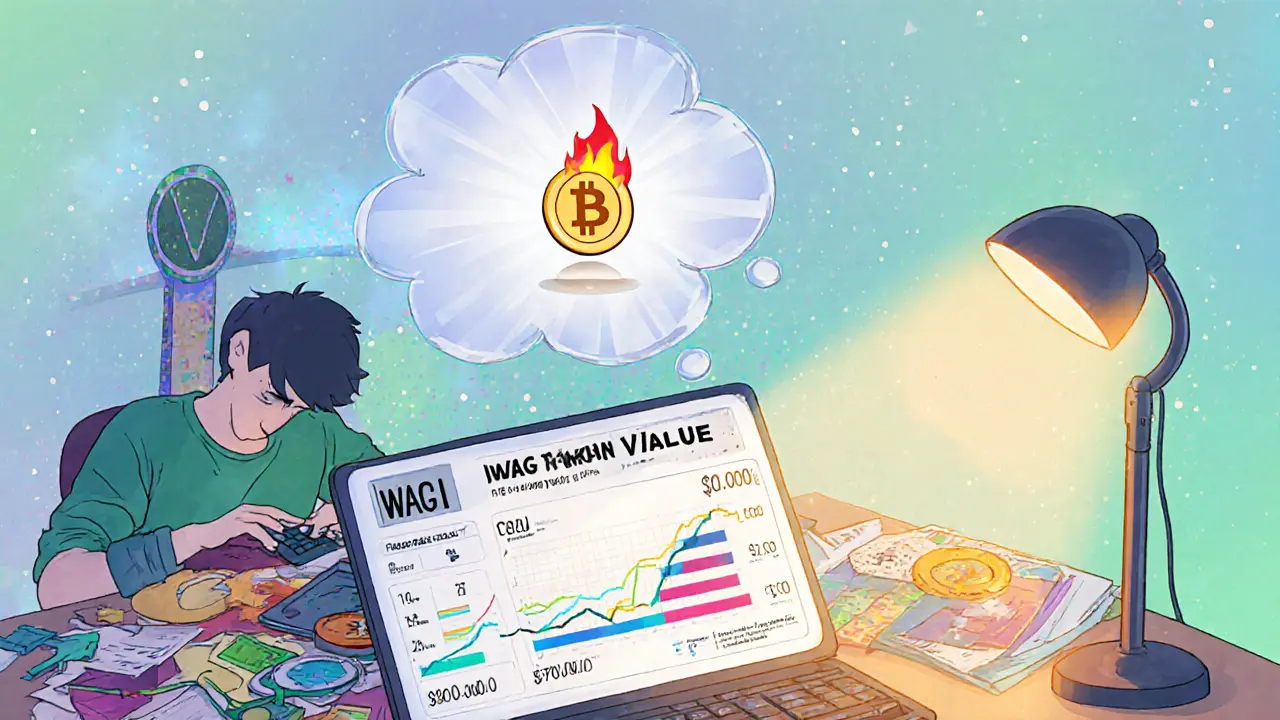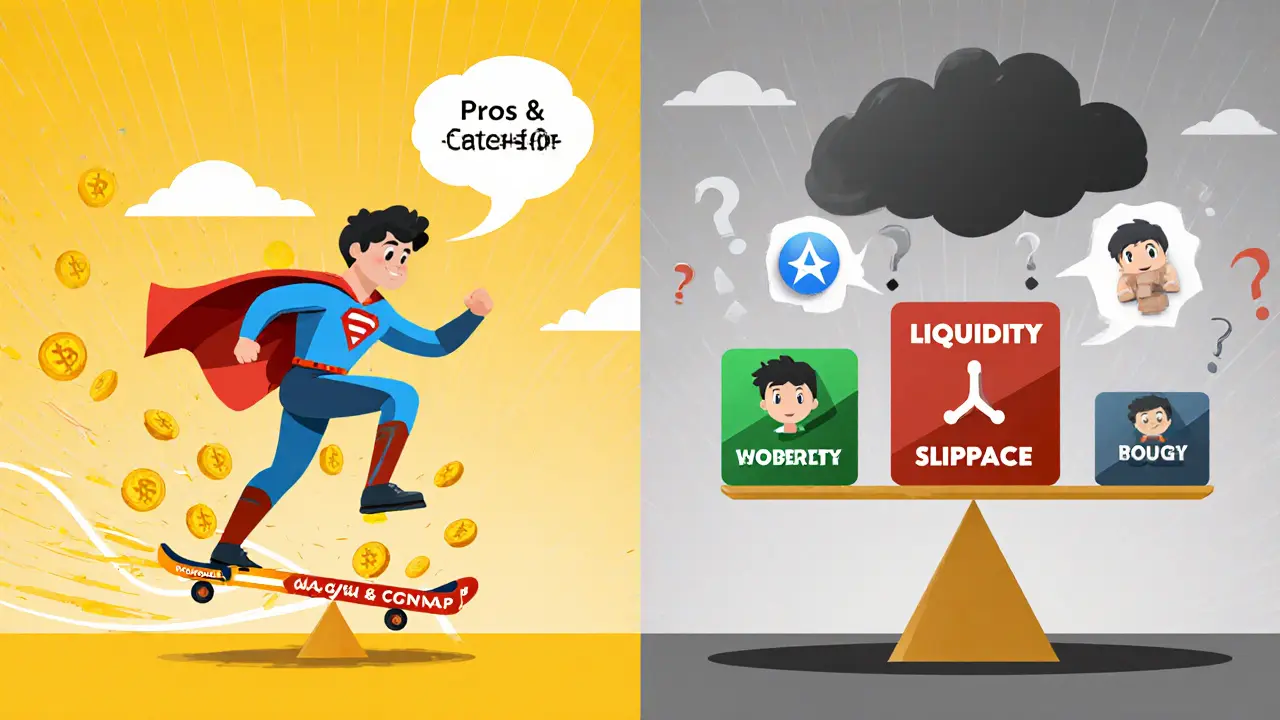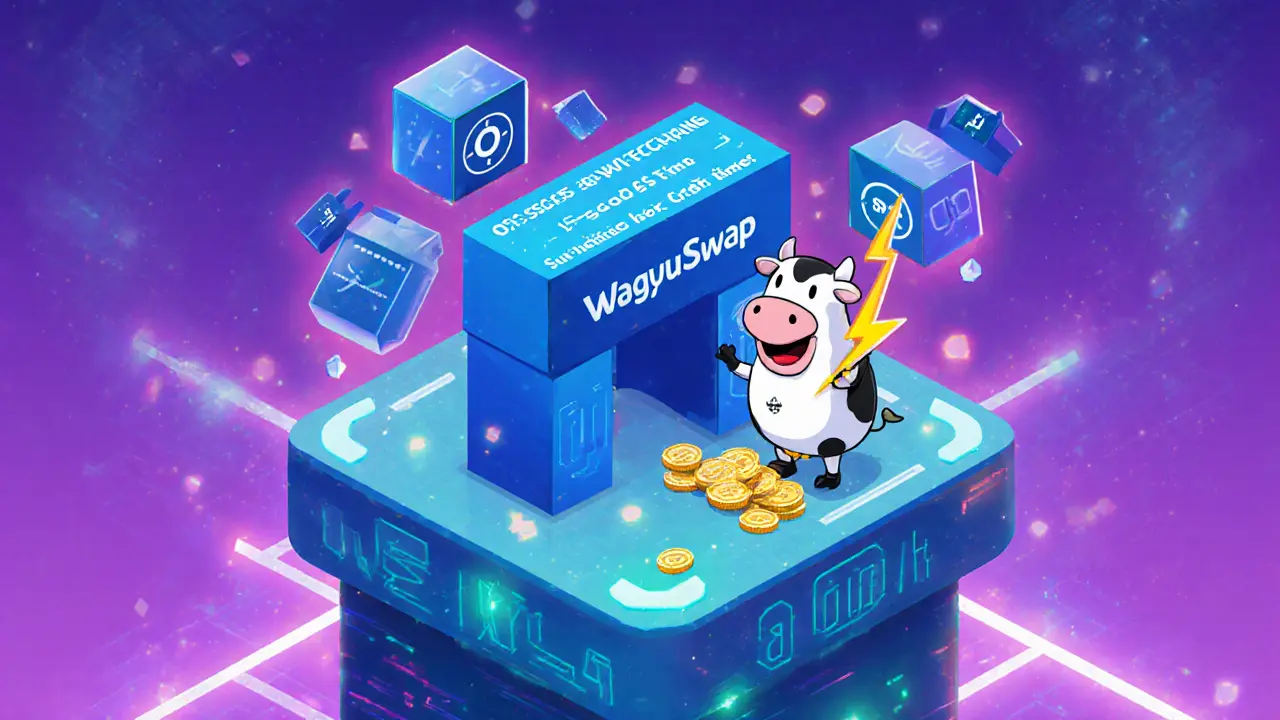WAG Token Value Calculator
Current WAG Token Info
Current Price: $0.00014
Circulating Supply: 46.8 million
Max Supply: 500 million
Market Cap: $6K - $20K
Calculator Inputs
Value Projection Results
Fee Comparison
On WagyuSwap:
0.05% swap fee ≈ $0.0003 per $1 trade
vs. Uniswap (Ethereum):
0.30% swap fee ≈ $0.003 per $1 trade
Savings: ~90% on fees!
Important Notes
- WAG token price is highly volatile
- Projecting growth rates is speculative
- Consider risk before investing
- Current liquidity is low on WagyuSwap
Quick Take
- First DEX on the Velas Network, touting sub‑second transaction speeds.
- Native token WAG trades around $0.00014 (Oct2025).
- Fees are fractions of a cent - far lower than Ethereum‑based DEXs.
- Liquidity is modest; 24‑hour volume often near $0, limiting large trades.
- Best for speed‑focused traders who can tolerate thin order books.
What Is WagyuSwap?
When you hear the name WagyuSwap is a decentralized exchange (DEX) built on the Velas Network blockchain. It launched as Velas’ inaugural DEX, positioning itself as the go‑to platform for traders who want ultra‑fast execution and rock‑bottom fees.
The Velas Network, introduced in 2020, blends Solana’s high‑throughput architecture with full EVM compatibility. Velas Network offers sub‑second block times and transaction fees that are a fraction of those on Ethereum, Binance Smart Chain or Bitcoin. This technical backbone is the core selling point of WagyuSwap.
How to Start Trading on WagyuSwap
- Set up a wallet that supports the Velas EVM (e.g., MetaMask configured for Velas, or the native Velas Wallet).
- Bridge assets from Ethereum, BSC or Solana onto Velas using a cross‑chain bridge. The bridge step adds a few minutes of latency but saves you on gas.
- Visit the WagyuSwap interface and connect your wallet.
- Select the token pair you want to trade, adjust slippage tolerance (5‑10% is common on thin markets), and confirm the swap.
- Withdraw your assets back to the original chain if needed, using the same bridge.
Because the platform is still maturing, expect occasional UI glitches and limited help‑desk support. Most community questions are answered on the Velas Discord or Telegram channels.
Tokenomics: The WAG Token
The native utility token, WAG functions as a governance and fee‑discount token on WagyuSwap, has a circulating supply of roughly 46.8million and a hard cap of 500million. Current price data (lateSept2025) places WAG around $0.00014, giving the token a market cap between $6K and $20K depending on the data source.
Key token attributes:
- Supply: 46.8M circulating / 500M max.
- Utility: Staking rewards, reduced swap fees, and voting on protocol upgrades.
- Liquidity: Mostly paired with USDT and USDC on Velas.
Price forecasts are mixed. Some analysts (3Commas) see a ceiling near $0.00029 by 2025, while more cautious models (LiteFinance) predict a range of $0.00012‑$0.00013. The token’s volatility is high - it peaked at $2.94 in 2021 and fell below $0.00011 in mid‑2025.

Performance vs. Established DEXs
Below is a quick side‑by‑side comparison of WagyuSwap with two market leaders.
| Metric | WagyuSwap | Uniswap (Ethereum) | PancakeSwap (BSC) |
|---|---|---|---|
| Blockchain | Velas (EVM‑compatible) | Ethereum | Binance Smart Chain |
| Avg. Block Time | ~0.5s | ~13s | ~3s |
| Typical Swap Fee | 0.05% (≈$0.0003 on $1 trade) | 0.30% (~$0.003 on $1 trade) | 0.20% (~$0.002 on $1 trade) |
| 24‑h Volume (USD) | ≈$0 - $5K | >$1B | >$300M |
| Liquidity (USDT pairs) | Low - < $10K | High - > $500M | Medium - $50M |
| Market Cap (Token) | $6K - $20K | $20B+ | $2B+ |
WagyuSwap wins on speed and fees, loses badly on liquidity and trading volume. If you’re moving small amounts and care about transaction cost, it can be a good niche tool. For big‑ticket trades, you’ll likely hit slippage on WagyuSwap.
Pros & Cons
- Pros
- Sub‑second transaction confirmation.
- Fees often under $0.001 per swap.
- Early‑adopter incentives via WAG staking.
- EVM compatibility means you can use familiar wallets.
- Cons
- Very low liquidity - large orders suffer high slippage.
- Limited UI polish and sparse documentation.
- Community size is small; few third‑party tutorials.
- Reliance on Velas adoption - if Velas stalls, WagyuSwap stalls.
Community, Support & Security
The platform’s Discord has under 1,000 members, and the Telegram channel sees only a few dozen daily messages. No major security audit reports are publicly posted, though the Velas team claims internal testing. Users should treat WagyuSwap as a high‑risk environment - keep only what you’re willing to lose.
Support is mostly community‑driven. The official website offers a short FAQ, but detailed guides (e.g., how to bridge tokens) are scattered across blog posts and third‑party videos.
Price Outlook for WAG
Technical analysis shows the token stuck in a prolonged downtrend since its 2021 peak. Moving averages (50‑day vs. 200‑day) are bearish, and volume is thin. Analyst consensus leans toward modest recovery if Velas gains traction, but most forecasts place WAG below $0.00015 through 2026.
Given the market’s “Greed” sentiment (Fear & Greed Index 74) and recent macro‑economic pressure, speculative spikes are possible but unlikely to be sustainable without a liquidity boost.
Bottom Line
WagyuSwap review shows a platform that lives up to its speed promises but struggles with the fundamentals that matter most to traders: deep liquidity and a vibrant user base. If you prioritize ultra‑low fees for small swaps and enjoy experimenting on new chains, give it a try. Otherwise, stick with more established DEXs until Velas proves its staying power.

Frequently Asked Questions
Is WagyuSwap safe to use?
Safety depends on the underlying blockchain. Velas has not been audited by a major firm, and WagyuSwap’s code is not fully open‑source. Use only small amounts until you’re comfortable with the risk.
How do I bridge assets to Velas?
Popular bridges include the official Velas Bridge and third‑party services like Multichain. Connect your wallet, select the source network, choose the token, and approve the transfer. Bridging can take 1‑5 minutes.
What fee discounts does holding WAG provide?
Staking 10,000WAG reduces swap fees from 0.05% to 0.04%. Higher stakes unlock deeper discounts, but the impact is modest compared to the already low baseline.
Can I provide liquidity on WagyuSwap?
Yes. The “Add Liquidity” page lets you pool any Velas‑compatible token pair. Expect low returns because of limited trading volume.
How does WagyuSwap compare to Uniswap on gas costs?
A $100 swap on Uniswap typically costs $2‑$3 in gas, while the same swap on WagyuSwap costs under $0.10, thanks to Velas’s sub‑cent fees.


WagyuSwap's sub‑second speeds are impressive, especially for those tired of waiting on Ethereum. The low fees definitely make it worth a quick look.
Sure, the latency metrics look slick, but the order‑book depth on Velas feels more like a sandbox experiment than a production‑grade liquidity pool. Without robust depth, those ‘sub‑second’ swaps risk massive slippage.
If you’re just dabbling with small amounts, WagyuSwap can be a low‑cost playground to get familiar with Velos‑based DEXes. It’s a neat stepping stone before moving to higher‑volume platforms.
But remember, every time you bridge assets you’re handing over a silent backdoor to the *unknown* elites pulling strings behind Velas’ shiny veneer.
Great, another DEX with zero volume.
You think that’s the whole story? The bridge contracts are practically open‑source riddles, and the hidden fee layers are buried in the code like a secret tax. Anyone savvy knows the real cost isn’t in the 0.05% headline but in the gas‑price spikes that the core developers never disclose. Store only what you can afford to lose, because the platform’s future is tied to a network that could disappear overnight.
From a regulatory perspective, the paucity of audited security reports on WagyuSwap raises legitimate concerns regarding investor protection.
I’d suggest starting with a modest $10 transfer just to test the bridge and monitor the transaction receipts. It’s the safest way to get comfortable with the process.
The WagyuSwap exposition, as delineated in the recent comprehensive review, epitomizes the archetypal tensions inherent in nascent decentralized finance ecosystems. On one hand, the platform’s sub‑second block finality, afforded by the Velas consensus architecture, represents a laudable engineering triumph over the latency constraints that have historically plagued Ethereum‑based exchanges. On the other hand, the liquidity metrics disclosed-a daily volume scarcely nudging the five‑thousand‑dollar threshold-betray a stark incongruity between performance promises and market adoption. Such a dichotomy is further accentuated by the tokenomics of the native WAG token, whose circulating supply hovers near forty‑seven million while the cap looms at half a billion, engendering a dilution vector that investors must contemplate. The price trajectory, oscillating between a nadir of $0.00011 and a speculative ceiling of $0.00029, is emblematic of an asset caught in a protracted bear market regime. Moreover, the fee structure, although ostensibly competitive at 0.05% per swap, yields negligible absolute cost savings when juxtaposed against the inherent opportunity cost of slippage in thin order books. The platform’s user experience, marred by occasional UI glitches and a paucity of comprehensive documentation, further compounds the adoption barrier. Community engagement, as evidenced by a Discord cohort numbering fewer than one thousand souls, suggests a limited network effect that is crucial for organic liquidity growth. The absence of a publicly disclosed third‑party security audit amplifies the risk profile, compelling prudent participants to treat the protocol as a high‑variance experimental sandbox. In contrast, legacy DEXs such as Uniswap and PancakeSwap boast deep liquidity pools, robust developer ecosystems, and transparent governance frameworks. Consequently, any trader envisaging sizable capital deployment should meticulously calibrate trade size to mitigate adverse price impact on WagyuSwap. That said, for micro‑transactions where fee minimization supersedes execution certainty, the platform’s economic model is compelling. It is also noteworthy that staking WAG tokens confers modest fee discounts, yet the marginal benefit is eclipsed by the token’s volatility. Prospective participants would be well‑served to monitor Velas’ broader ecosystem developments, including upcoming scalability upgrades and cross‑chain bridge enhancements. Ultimately, WagyuSwap occupies a niche stratum within the DeFi hierarchy: a speed‑centric, low‑fee venue that nevertheless wrestles with the fundamental liquidity imperatives of a sustainable exchange. Whether this niche will crystallize into a durable market segment remains an open question, contingent upon network effects and community stewardship.
Ths review suugests tht WagyuSwap’s low feez are a guud start, but the liqidity is stilly rly thin. I thnk you need more users to make it work.
Liquidity constraints are the main hurdle for widespread adoption.
In summation, the risk‑adjusted return profile of WAG token investments appears marginal when benchmarked against established DeFi assets, thereby necessitating a cautious allocation strategy.
Oh sure, the Velas network is the *miraculous* unicorn that will magically solve all our fee woes, while the hidden fees silently gnaw at your portfolio like mischievous gremlins dancing in the shadows of the blockchain abyss.
Contemplating the epistemic boundaries of decentralized exchanges invites us to question whether true liquidity is an illusion or a construct of collective belief 😊.
Patriotic users love free trades but forget the market's reality.
Give it a shot, you might be surprised how cheap a tiny trade can be!
For newcomers, I recommend reading the Velas Bridge tutorial on the official docs and testing with a small amount before committing larger capital.
I’ve seen a few traders actually profit on micro‑arbitrage between WagyuSwap and PancakeSwap during low‑volume windows, so keep an eye on price differentials.
That strategy works only if you monitor the spreads closely.
Most users ignore the liquidity issue and end up with slippage they didn’t anticipate.